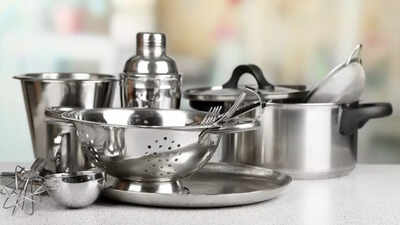
A growing number of young consumers are redefining their approach to everyday cooking, choosing functionality, health, and sustainability over short-term convenience. Generation Z, known for its preference for quality-driven and eco-conscious products, is increasingly turning to stainless steel cookware as a practical and long-lasting alternative to traditional non-stick or aluminium pans. This shift mirrors a broader movement towards mindful consumption and awareness of material safety in home environments. According to Grand View Research, the global stainless steel cookware market was valued at USD 8.69 billion in 2024 and is projected to reach USD 12.46 billion by 2030, reflecting a compound annual growth rate (CAGR) of 6.2 percent, driven by rising demand for durable, health-friendly, and sustainable cookware solutions.
What makes steel cookware healthy and safe
Health considerations play a central role in why Gen Z consumers are abandoning non-stick cookware in favour of stainless steel. Many traditional non-stick coatings can degrade over time, releasing unwanted compounds at high temperatures. Stainless steel, however, is a non-reactive alloy made by combining iron with chromium and nickel, preventing leaching and preserving the nutritional quality of food. Grand View Research identifies stainless steel’s ability to resist corrosion and maintain food safety as a major factor in its surging popularity among younger households. With the increasing public discourse surrounding the safety of kitchen materials, Gen Z’s preference for stainless steel reflects an evidence-informed commitment to everyday wellness and clean cooking practices.
How durability of steel cookware makes them a good investment
For Gen Z consumers balancing modern lifestyles with sustainability, durability is both an economic and environmental consideration. Stainless steel’s robust structure allows it to endure repeated use, high heat, and intensive cleaning without losing its integrity. The Grand View Research report highlights that multi-layered or clad stainless steel, often bonded with aluminium or copper for improved heat distribution, has enhanced the performance of modern cookware, making it suitable for a range of cooking techniques. This structural innovation allows heat to spread evenly, preventing hot spots and promoting efficient energy use. The long lifespan of steel cookware also reduces replacement frequency, aligning with Gen Z’s preference for long-term, low-waste products that contribute to responsible consumption.
Why steel utensils are eco-friendly and good for the environment
Environmental awareness is deeply ingrained in Gen Z’s consumer identity, and stainless steel aligns well with this ethos. According to the report, growing interest in sustainable manufacturing processes and recyclable materials has become a defining market trend. Stainless steel is 100 percent recyclable without degradation in quality, reducing landfill accumulation and conserving natural resources. Manufacturers are increasingly adopting eco-conscious methods such as impact bonding and the use of “green steel,” which lowers carbon emissions during production. As sustainability continues to shape global purchasing behaviour, the demand for ethically produced cookware that supports circular economies is expected to expand, making stainless steel a preferred option for the environmentally aware younger generation.
Digital influence boosts embracement of steel cookware
The pandemic-induced rise in home cooking has had a lasting impact on how Gen Z interacts with food and kitchenware. Grand View Research attributes much of the market growth in residential cookware sales, over 67 percent of global share in 2024, to renewed interest in preparing meals at home. Social media platforms such as Instagram and TikTok have amplified this shift, turning cooking into a lifestyle statement. Stainless steel cookware, with its sleek design and professional aesthetic, has become a visible marker of quality and authenticity in online food culture. Beyond visual appeal, its resilience and compatibility with induction cooktops suit modern urban kitchens, reinforcing its popularity among younger consumers who value both functionality and form.
The ever-growing steel cookware market
Asia Pacific is identified as the largest regional market for stainless steel cookware, driven by urbanisation, rising disposable incomes, and a growing middle-class population. Countries such as India and China are seeing rapid adoption as young professionals invest in durable kitchenware that complements evolving culinary habits. Meanwhile, North America and Europe continue to show steady growth, supported by the commercial food service sector and the premium home goods market. Overall, the market’s steady CAGR of 6.2 percent reflects how stainless steel cookware has evolved beyond a utilitarian tool into a lifestyle product. For Gen Z, its combination of safety, sustainability, and style represents a conscious response to the changing values that define modern living.Also Read | Unearthing Patagonia’s hidden past: A rare dinosaur egg challenges ancient evolutionary narratives








